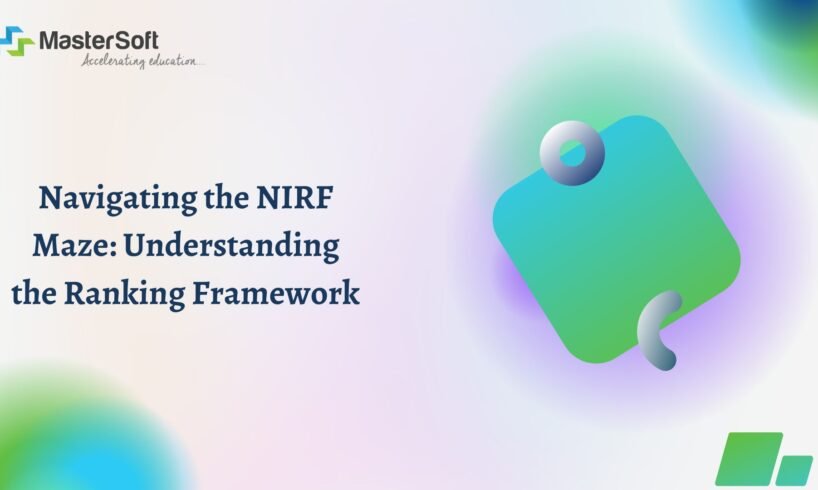
In the realm of higher education, the National Institutional Ranking Framework (NIRF) has become a guiding beacon for students, educators, and institutions alike. Introduced by the Ministry of Human Resource Development (MHRD) in 2015, NIRF aims to provide a comprehensive and transparent evaluation of Indian higher education institutions. As students embark on the journey of choosing the right academic path, understanding the intricacies of the NIRF ranking framework becomes crucial. In this blog, we’ll navigate the NIRF maze, shedding light on its components, significance, and the impact it has on the educational landscape.
The Genesis of NIRF:
Before delving into the intricacies of National Institutional Ranking Framework, it’s essential to understand its genesis. The framework was established with the objective of promoting excellence in education and fostering healthy competition among institutions. Recognizing the need for a standardized system to assess and rank educational institutions, the MHRD conceptualized NIRF to serve as a comprehensive and reliable ranking mechanism.
Components of NIRF Ranking:
NIRF employs a multi-dimensional approach to evaluate institutions, considering various parameters to ensure a holistic assessment. The key components of the NIRF ranking framework include:
- Teaching, Learning, and Resources: This parameter evaluates the core activities of an institution, focusing on the quality of teaching, student-teacher ratio, and the availability of resources for effective learning.
- Research and Professional Practice: Research plays a pivotal role in the academic landscape. NIRF assesses institutions based on their research output, innovation, and the impact of their professional practices.
- Graduation Outcomes: The success of an educational institution is reflected in the outcomes of its graduates. NIRF considers factors such as placement statistics, median salary, and the percentage of students graduating within the stipulated time.
- Outreach and Inclusivity: This parameter emphasizes an institution’s commitment to societal engagement, regional diversity, and inclusivity. It evaluates the efforts made by an institution to reach out to communities and provide accessible education.
- Perception: National Institutional Ranking Framework also considers the perception of an institution, both from the academic and industrial perspectives. This includes peer perception, employer perception, and the public perception of an institution’s credibility.
Significance of NIRF Rankings:
Understanding the National Institutional Ranking Frameworkranking framework is crucial for both students and institutions due to its significant impact on the educational landscape. Here are some reasons why NIRF rankings hold importance:
- Informed Decision-Making: For students, NIRF rankings serve as a valuable tool for making informed decisions about their academic future. By considering the rankings, students can identify institutions that align with their preferences and academic goals.
- Institutional Benchmarking: For educational institutions, National Institutional Ranking Framework rankings provide a benchmark for performance. Institutions can use these rankings to identify areas of improvement, enhance their academic offerings, and strive for excellence in various parameters.
- Recognition and Visibility: Higher National Institutional Ranking Frameworkrankings contribute to an institution’s recognition and visibility on a national level. This recognition can attract quality faculty, researchers, and students, fostering an environment of academic excellence.
- Funding and Collaboration Opportunities: Institutions with higher NIRF rankings often attract more funding and collaboration opportunities. This can lead to research partnerships, industry collaborations, and the overall enhancement of the institution’s academic ecosystem.
Challenges and Criticisms:
While NIRF has undoubtedly played a significant role in reshaping the Indian higher education landscape, it is not without its challenges and criticisms. Some common concerns include:
- Parameter Subjectivity: The perception parameter, which relies on subjective opinions, has faced criticism for its potential lack of objectivity. Critics argue that subjective opinions may not accurately reflect an institution’s true academic prowess.
- Weightage Imbalance: The allocation of weightages to different parameters has been a subject of debate. Some argue that certain parameters may carry more weight than others, potentially skewing the overall ranking.
- Limited Scope: NIRF primarily focuses on traditional metrics and may not fully capture the diverse and evolving nature of modern education. Critics argue for the inclusion of additional parameters that reflect the dynamic nature of academic excellence.
Conclusion:
Navigating the NIRF maze is a crucial aspect of the higher education journey in India. As students explore their academic options and institutions strive for excellence, understanding the ranking framework becomes paramount.




